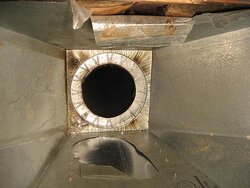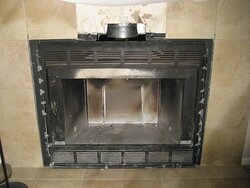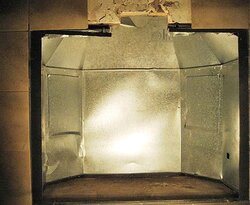I'm pretty stuck, and our house is getting rather cold  . We bought a 1977 house with a decaying Heatilator Mark 123 wood burning insert. The heat tiles were half gone, sides bowed out, and we knew it would need to get swapped out. I picked up a great condition 1980's Superior/Lennox CF-3860 wood insert (for free).
. We bought a 1977 house with a decaying Heatilator Mark 123 wood burning insert. The heat tiles were half gone, sides bowed out, and we knew it would need to get swapped out. I picked up a great condition 1980's Superior/Lennox CF-3860 wood insert (for free).
So, I sawzalled out the Heatilator from the front, gutting it down to the outer galvanized paneling that contained the fiber insulation that lined the inner fireplace. The top flue connection and firestop are still intact.
I thought this was a workable situation. I cut some temporary flaps in the outer steel paneling to stuff the original insulation back behind it (because it's just drywall there separating our garage). Then I would slide the new wood insert in, connect the flue, and we'd be set. There is easily a 2-6" air gap on all sides of the new insert, and beyond that is still the original galvanized paneling-- no combustibles. The new insert says it only needs 1 inch of air clearance, so I was leaning towards "reasonably safe" so far.
Well, now I realize the original Heatilator and chimney use a 9" inner diameter pipe, which is nearly impossible to find, whereas the newer Superior insert uses 8" ID. Not only that, the existing flue is about 4-5" off plumb from the new insert, which I guess will require some type of adjustable elbow connection.
Finally, there's the matter of shielding the new flue piece(s). I'm not sure if I really need a double-walled flue? There will be 4-24" of air between the new flue and older galvanized paneling (still no combustibles). The original Heatilator inner steel liner had a lot less clearance to that outside paneling, although there was fiberglass insulation between them.
If additional flue protection is needed, since it's so difficult to find proper sizing for this, maybe I can place 12" diameter galvanized air ducting around the inner pipe to help insulate it? Regardless, it looks like I'm going to need to create some kind of 9-8" flue adapter on my own any way.
If I hire a professional for this, I imagine the answer will be, "You need to buy a new wood insert ($1.5-2k), and we'll need to replace the chimney to fit its newer 6-inch pipe ($2-4k+?)".
(Pictures below show the existing chimney connection, a test fit of the newer Superior insert, and the empty cavity with the original galvanized surround paneling.)
 . We bought a 1977 house with a decaying Heatilator Mark 123 wood burning insert. The heat tiles were half gone, sides bowed out, and we knew it would need to get swapped out. I picked up a great condition 1980's Superior/Lennox CF-3860 wood insert (for free).
. We bought a 1977 house with a decaying Heatilator Mark 123 wood burning insert. The heat tiles were half gone, sides bowed out, and we knew it would need to get swapped out. I picked up a great condition 1980's Superior/Lennox CF-3860 wood insert (for free).So, I sawzalled out the Heatilator from the front, gutting it down to the outer galvanized paneling that contained the fiber insulation that lined the inner fireplace. The top flue connection and firestop are still intact.
I thought this was a workable situation. I cut some temporary flaps in the outer steel paneling to stuff the original insulation back behind it (because it's just drywall there separating our garage). Then I would slide the new wood insert in, connect the flue, and we'd be set. There is easily a 2-6" air gap on all sides of the new insert, and beyond that is still the original galvanized paneling-- no combustibles. The new insert says it only needs 1 inch of air clearance, so I was leaning towards "reasonably safe" so far.
Well, now I realize the original Heatilator and chimney use a 9" inner diameter pipe, which is nearly impossible to find, whereas the newer Superior insert uses 8" ID. Not only that, the existing flue is about 4-5" off plumb from the new insert, which I guess will require some type of adjustable elbow connection.
Finally, there's the matter of shielding the new flue piece(s). I'm not sure if I really need a double-walled flue? There will be 4-24" of air between the new flue and older galvanized paneling (still no combustibles). The original Heatilator inner steel liner had a lot less clearance to that outside paneling, although there was fiberglass insulation between them.
If additional flue protection is needed, since it's so difficult to find proper sizing for this, maybe I can place 12" diameter galvanized air ducting around the inner pipe to help insulate it? Regardless, it looks like I'm going to need to create some kind of 9-8" flue adapter on my own any way.
If I hire a professional for this, I imagine the answer will be, "You need to buy a new wood insert ($1.5-2k), and we'll need to replace the chimney to fit its newer 6-inch pipe ($2-4k+?)".

(Pictures below show the existing chimney connection, a test fit of the newer Superior insert, and the empty cavity with the original galvanized surround paneling.)




